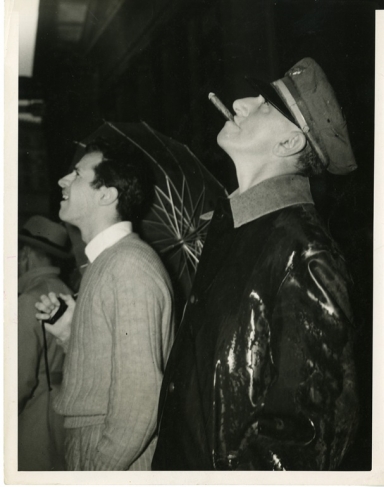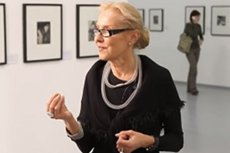«The naked city»: New York, Los Angeles. From Jean Pigozzi's collection
![Weegee.
[Two police officers who dove into Hudson River to save Donna Landon, New York], July 20, 1941.
© Weegee/International Center of Photography/Getty Images](/upload/iblock/7ba/7ba597a201325e1f748441f06c9f6aad.jpg)

![Weegee.
[Billie Dauscha and Mabel Sidney, Bowery entertainers, New York], December 4, 1944.
© Weegee/International Center of Photography/Getty Images](/upload/iblock/c9f/c9fd8c348070a4f8781ac35fadef5935.jpg)
![Weegee.
[Mayor Fiorello La Guardia at the circus, New York], ca. 1943.
© Weegee/International Center of Photography/Getty Images](/upload/iblock/c7f/c7f979566563882adbcdb37818dcdad6.jpg)
![Weegee.
[Woman sliding down banister, Greenwich Village, New York], ca. 1956.
© Weegee/International Center of Photography/Getty Images](/upload/iblock/4e7/4e7801bdcfe2b1df72771edf77817b56.jpg)

![Weegee.
[Nude woman], ca. 1955.
© Weegee/International Center of Photography/Getty Images](/upload/iblock/c2f/c2f575f896ef1102a825e2e8803af51b.jpg)
Weegee. [Two police officers who dove into Hudson River to save Donna Landon, New York], July 20, 1941. © Weegee/International Center of Photography/Getty Images
Weegee. The Critic, November 22, 1943. © Weegee/International Center of Photography/Getty Images
Weegee. [Billie Dauscha and Mabel Sidney, Bowery entertainers, New York], December 4, 1944. © Weegee/International Center of Photography/Getty Images
Weegee. [Mayor Fiorello La Guardia at the circus, New York], ca. 1943. © Weegee/International Center of Photography/Getty Images
Weegee. [Woman sliding down banister, Greenwich Village, New York], ca. 1956. © Weegee/International Center of Photography/Getty Images
Weegee. Emotion—Watching man on ledge at Municipal Bldg., ca. 1939. © Weegee/International Center of Photography/Getty Images
Weegee. [Nude woman], ca. 1955. © Weegee/International Center of Photography/Getty Images
For the press
Weegee, the moniker that made Arthur Fellig, an American photographer from the town of Złoczów, near Lvov, famous, can be interpreted in several ways. According to one version, «Weegee» is derived from the Ouija board, in which a planchette is used in séances to make contact with ghosts and to predict the future. Weegee could lay claim to such paranormal abilities based on his phenomenal knack for arriving early at a crime scene, often even before the police. But Weegee’s secret had little to do with prognostication: he just listened in on the police radio communications that were wired directly to his car and his studio.
Weegee’s work contains many such secrets, which might be better described as misdirections. In his most Gothic photo—in which two ghostly figures, with giant white cones concealing their heads, lean over a bed with a bloody body in it—was a clear mystification, immediately exposed. As a matter of fact, it is a diorama from the Coney Island Wax Museum, representing, as the title provided by Weegee says, «Ruth Snyder, a housewife from Queens, who murdered her husband in 1927.» Of course, Weegee’s photographs reveal a lot of real corpses as well, but even there he surprises the viewer by being the most realistic photographer in relation to death. His photographs do not represent the deceased as the dearly departed or even as theatrically scary corpses: there are just dead bodies, without any hint at life after death. They are not shown as victims of some crime, but merely as evidence of that crime, in all their lumpen materiality. Living persons—mainly criminals and those who follow and detain them—were much more interesting to Weegee, and yet he photographed them with the same impartial, if wide-eyed, curiosity.
Weegee did not see himself as an artist. He cherished the image of himself as a hired gun, a cynical and fearless detective, like the private eyes from noir novels and films, and it is hard to avoid classifying him this way. He brandished his skills as a clever inquisitor and energetic reporter, and in the world of tabloid journalism he also excelled as a sensation hunter and a fast and ingenious craftsman. After thirty years’ experience in the darkroom, Weegee could reportedly develop and print photographs in a moving subway car or in the bathroom of his tiny studio. He saw photography as a business, and he claimed that if he were to shoot two criminals chained together, he would cut them apart and sell each as a single shot to double his revenue. Nevertheless, the artistic quality of Weegee’s photographs was always acknowledged and he won recognition in art circles quite soon. He had two one-person shows at the Photo League in 1941, and in 1943 the Museum of Modern Art in New York purchased five of his photographs for its Action Photography exhibition.
Weegee is often referred to as the American Brassaï. This implies that Weegee’s New York, the city of marginal types, criminals, and other dark characters, was also a discovery, a kind of terra incognita, just like the nighttime Paris of his French colleague. Yet, no matter how unusual and bizarre his images looked, Weegee was never a surrealist like Brassaï. Weegee never strived to create a different, parallel, otherworldly, or ghostly reality. On the contrary, one could say that he championed equal rights for the reality of all. Social pathos was not alien to Weegee. He specialized in depicting without prejudice the most bizarre, incredible characters, those who are usually deprived of representation. Here, one might think of his many portraits of the grotesque regulars and has-been performers at Sammy’s, a Bowery cabaret frequented by the photographer himself, or the pictures Weegee took inside movie theaters with infrared film showing moviegoers laughing and necking, sure of their invisibility. Even if these folks wanted to hide in a different reality, Weegee’s snapshots forced them back into the limelight.
Weegee had nothing against the inventions of the cinema: quite the contrary. In the late 1940s, when the rights to his popular photo book Naked City were purchased by a prominent film producer, Weegee actively cooperated with filmmakers, working as set photographer and appearing as a bit player. He even moved to Hollywood to pursue acting, and he stayed till 1952 when he returned to New York. Weegee shot several short experimental films himself, and in 1958 he worked on the film Dr. Strangelove with director Stanley Kubrick, who also started his career as a New York street photographer.
It is hard to say whether his brief experience of the Dream Factory had any influence on Weegee, but it was in Los Angeles that new motives began to appear amid his previously unflinching realism. He undertook strange formalist experiments, making portraits of Hollywood stars such as Marilyn Monroe, Elizabeth Taylor, and Judy Garland through special lenses, distorting their faces as if looking at them through funhouse mirrors. Weegee pursued this sort of trick photography until the end of his life, in 1968. Salvador Dalí and Andy Warhol were fans of Weegee’s work and appear in it themselves, gaudily distorted among various other celebrities. Weegee called these experiments «distortions»; his contemporaries saw them as humorous caricatures. But these photos look deliberately weird, rather than funny. And it is not for nothing that they resemble the deceptive photographs of otherworldly phantasms, ones that supposedly emerge during séances, and other forms of misdirection.
Irina Kulik












